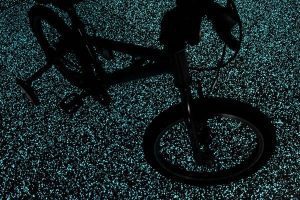Pathway Spray Makes Pedestrian Walkways Glow
by Blaine Brownell
A new pathway spray product absorbs UV rays by day, and glows by night

U.K.-based manufacturer Pro-Teq Surfacing, however, has developed a low-cost spray-based surfacing product called Starpath that can be applied to a variety of existing pathway base materials such as concrete, asphalt, or timber. The elastomeric material contains phosphorescent aggregates that absorb ultraviolet radiation during the day and release low-level lighting in the evening. According to Pro-Teq, the application improves degraded pathways with a smooth, anti-slip coating, but can also result in energy savings since fewer streetlights are needed for nighttime visibility.

Although Starpath represents a noteworthy improvement in self-illuminated surfacing applications, the low intensity and diffuse quality of illumination is not adequate for ensuring pedestrian safety, which requires street lighting that clearly reveals the features and behavior of other pedestrians. However, the technology may allow for a reduction in the number and frequency of streetlights, as well as a complete elimination of pedestrian lighting in safe areas. Such a change would not only reduce energy consumption, but also enhance the visibility of the nighttime sky, revealing stars in the firmament as well as on the ground.


0 comments